-
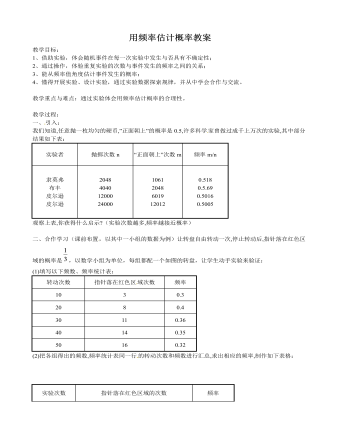
北师大初中数学九年级上册用频率估计概率2教案
(1)填写表格中次品的概率.(2)从这批西装中任选一套是次品的概率是多少?(3)若要销售这批西装2000件,为了方便购买次品西装的顾客前来调换,至少应该进多少件西装?六、课堂小结:尽管随机事件在每次实验中发生与否具有不确定性,但只要保持实验条件不变,那么这一事件出现的频率就会随着实验次数的增大而趋于稳定,这个稳定值就可以作为该事件发生概率的估计值。七、作业:课后练习补充:一个口袋中有12个白球和若干个黑球,在不允许将球倒出来数的前提下,小亮为估计口袋中黑球的个数,采用了如下的方法:每次先从口袋中摸出10个球,求出其中白球与10的比值,再把球放回袋中摇匀。不断重复上述过程5次,得到的白求数与10的比值分别为:0.4,0.1,0.2,0.1,0.2。根据上述数据,小亮可估计口袋中大约有 48 个黑球。
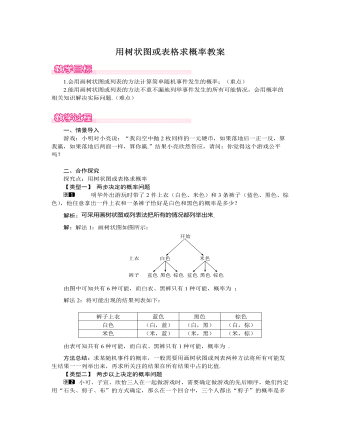
北师大初中数学九年级上册用树状图或表格求概率1教案
由上表可知,共有6种结果,且每种结果是等可能的,其中两次摸出白球的结果有2种,所以P(两次摸出的球都是白球)=26=13;(2)列表如下:由上表可知,共有9种结果,且每种结果是等可能的,其中两次摸出白球的结果有4种,所以P(两次摸出的球都是白球)=49.方法总结:在试验中,常出现“放回”和“不放回”两种情况,即是否重复进行的事件,在求概率时要正确区分,如利用列表法求概率时,不重复在列表中有空格,重复在列表中则不会出现空格.三、板书设计用树状图或表格求概率画树状图法列表法通过与学生现实生活相联系的游戏为载体,培养学生建立概率模型的思想意识.在活动中进一步发展学生的合作交流意识,提高学生对所研究问题的反思和拓展的能力,逐步形成良好的反思意识.鼓励学生思维的多样性,发展学生的创新意识.
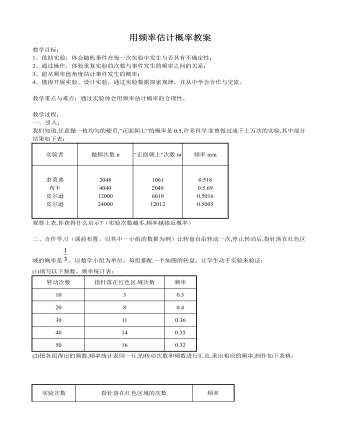
北师大初中数学九年级上册用频率估计概率2教案
(4)议一议:频率与概率有什么区别和联系?随着重复实验次数的不断增加,频率的变化趋势如何?结论:从上面的试验可以看到:当重复实验的次数大量增加时,事件发 生的频率就稳定在相应的概率附近,因此,我们可以通过大量重复实验,用一个事件发生的频率来估计这一事件发生的概率。三、做一做:1.某运动员投篮5次, 投中4次,能否说该运动员投一次篮,投中的概率为4/5?为什么?2.回答下列问题:(1)抽检1000件衬衣,其中不合格的衬衣有2件,由 此估计抽1件衬衣合格的概率是多少?(2)1998年,在美国密歇根州汉诺城市的一个农场里出生了1头白色的小奶牛,据统计,平均出生1千万头牛才会有1头是白色的,由此估计出生一头奶牛为白色的概率为多少?
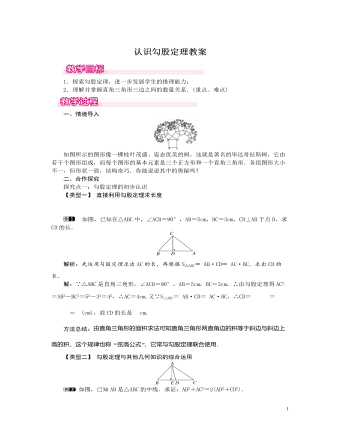
北师大初中数学八年级上册认识勾股定理1教案
方法总结:题中未给出图形,作高构造直角三角形时,易漏掉钝角三角形的情况.如在本例题中,易只考虑高AD在△ABC内的情形,忽视高AD在△ABC外的情形.探究点二:利用勾股定理求面积如图,以Rt△ABC的三边长为斜边分别向外作等腰直角三角形.若斜边AB=3,则图中△ABE的面积为________,阴影部分的面积为________.解析:因为AE=BE,所以S△ABE=12AE·BE=12AE2.又因为AE2+BE2=AB2,所以2AE2=AB2,所以S△ABE=14AB2=14×32=94;同理可得S△AHC+S△BCF=14AC2+14BC2.又因为AC2+BC2=AB2,所以阴影部分的面积为14AB2+14AB2=12AB2=12×32=92.故填94、92.方法总结:求解与直角三角形三边有关的图形面积时,要结合图形想办法把图形的面积与直角三角形三边的平方联系起来,再利用勾股定理找到图形面积之间的等量关系.
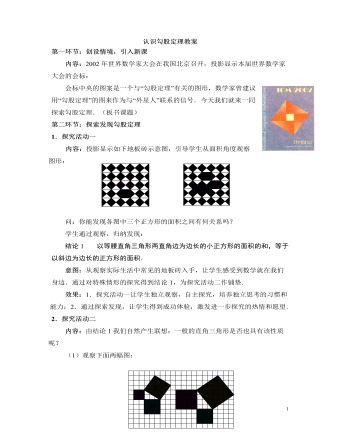
北师大初中数学八年级上册认识勾股定理2教案
意图:课后作业设计包括了三个层面:作业1是为了巩固基础知识而设计;作业2是为了扩展学生的知识面;作业3是为了拓广知识,进行课后探究而设计,通过此题可让学生进一步认识勾股定理的前提条件.效果:学生进一步加强对本课知识的理解和掌握.教学设计反思(一)设计理念依据“学生是学习的主体”这一理念,在探索勾股定理的整个过程中,本节课始终采用学生自主探索和与同伴合作交流相结合的方式进行主动学习.教师只在学生遇到困难时,进行引导或组织学生通过讨论来突破难点.(二)突出重点、突破难点的策略为了让学生在学习过程中自我发现勾股定理,本节课首先情景创设激发兴趣,再通过几个探究活动引导学生从探究等腰直角三角形这一特殊情形入手,自然过渡到探究一般直角三角形,学生通过观察图形,计算面积,分析数据,发现直角三角形三边的关系,进而得到勾股定理.
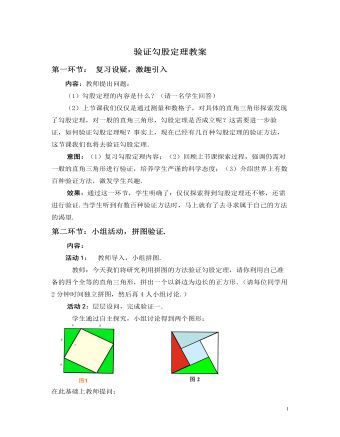
北师大初中数学八年级上册验证勾股定理2教案
意图:(1)介绍与勾股定理有关的历史,激发学生的爱国热情;(2)学生加强了对数学史的了解,培养学习数学的兴趣;(3)通过让部分学生搜集材料,展示材料,既让学生得到充分的锻炼,同时也活跃了课堂气氛.效果:学生热情高涨,对勾股定理的历史充满了浓厚的兴趣,同时也为中国古代数学的成就感到自豪.也有同学提出:当代中国数学成就不够强,还应发奋努力.有同学能意识这一点,这让我喜出望外.第六环节: 回顾反思 提炼升华内容:教师提问:通过这节课的学习,你有什么样的收获?师生共同畅谈收获.目的:(1)归纳出本节课的知识要点,数形结合的思想方法;(2)教师了解学生对本节课的感受并进行总结;(3)培养学生的归纳概括能力.效果:由于这节课自始至终都注意了调动学生学习的积极性,所以学生谈的收获很多,包括利用拼图验证勾股定理中蕴含的数形结合思想,学生对勾股定理的历史的感悟及对勾股定理应用的认识等等.
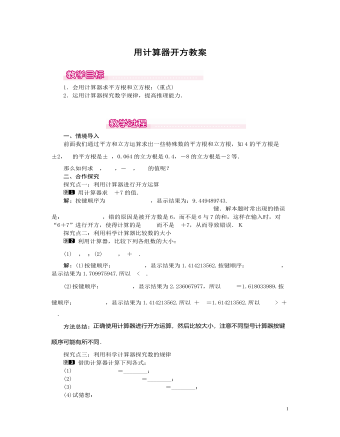
北师大初中数学八年级上册用计算器开方1教案
1.会用计算器求平方根和立方根;(重点)2.运用计算器探究数字规律,提高推理能力.一、情境导入前面我们通过平方和立方运算求出一些特殊数的平方根和立方根,如4的平方根是±2,116的平方根是±14,0.064的立方根是0.4,-8的立方根是-2等.那么如何求3,189,-39,311的值呢?二、合作探究探究点一:利用计算器进行开方运算 用计算器求6+7的值.解:按键顺序为■6+7=SD,显示结果为:9.449489743.方法总结:当被开方数不是一个数时,输入时一定要按键.解本题时常出现的错误是:■6+7=SD,错的原因是被开方数是6,而不是6与7的和,这样在输入时,对“6+7”进行开方,使得计算的是6+7而不是6+7,从而导致错误.K探究点二:利用科学计算器比较数的大小利用计算器,比较下列各组数的大小:(1)2,35;(2)5+12,15+2.解:(1)按键顺序:■2=SD,显示结果为1.414213562.按键顺序:SHIFT■5=,显示结果为1.709975947.所以2<35.
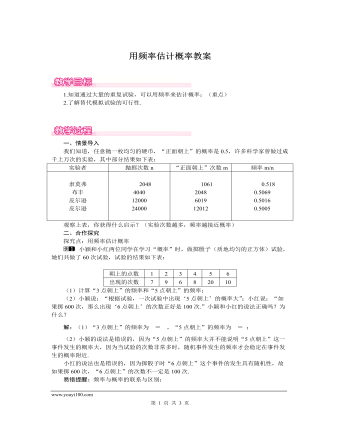
北师大初中数学九年级上册用频率估计概率1教案
(2)假如你摸一次,估计你摸到白球的概率P(白球)=;(3)试估算盒子里黑球有多少个.解:(1)0.6(2)0.6(3)设黑球有x个,则2424+x=0.6,解得x=16.经检验,x=16是方程的解且符合题意.所以盒子里有黑球16个.方法总结:本题主要考查用频率估计概率的方法,当摸球次数增多时,摸到白球的频率mn将会接近一个数值,则可把这个数值近似看作概率,知道了概率就能估算盒子里黑球有多少个.三、板书设计用频率估计概率用频率估计概率用替代物模拟试验估计概率通过实验,理解当实验次数较大时实验频率稳定于理论频率,并据此估计某一事件发生的概率.经历实验、统计等活动过程,进一步发展学生合作交流的意识和能力.通过动手实验和课堂交流,进一步培养学生收集、描述、分析数据的技能,提高数学交流水平,发展探索、合作的精神.
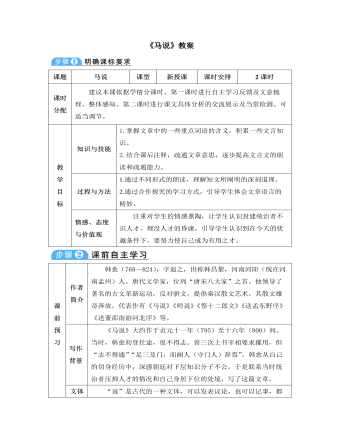
部编版语文八年级下册《马说》教案
课时分配 建议本课依据学情分课时。第一课时进行自主学习反馈及文意梳理、整体感知。第二课时进行课文具体分析的交流展示及当堂检测。可适当调节。教学目标 知识与技能 1.掌握文章中的一些重点词语的含义,积累一些文言知识。2.结合课后注释,疏通文章意思,逐步提高文言文的朗读和疏通能力。过程与方法 1.通过不同形式的朗读,理解短文所阐明的深刻道理。2.通过合作探究的学习方式,引导学生体会文章语言的精妙。情感、态度与价值观 注重对学生的情感熏陶,让学生认识封建统治者不识人才、埋没人才的昏庸,引导学生认识到在今天的优越条件下,要努力使自己成为有用之才。
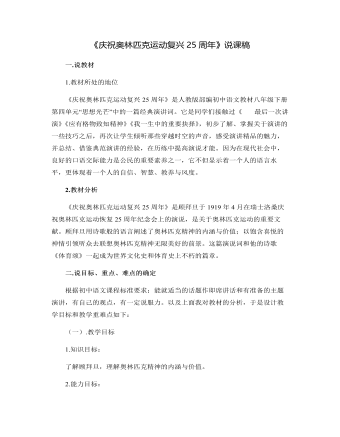
部编版语文八年级下册《庆祝奥林匹克运动复兴25周年》说课稿
一.说教材 1.教材所处的地位《庆祝奥林匹克运动复兴25周年》是人教版部编初中语文教材八年级下册第四单元“思想光芒”中的一篇经典演讲词。它是同学们接触过《 最后一次讲演》《应有格物致知精神》《我一生中的重要抉择》,初步了解、掌握关于演讲的一些技巧之后,再次让学生倾听那些穿越时空的声音,感受演讲精品的魅力,并总结、借鉴典范演讲的经验,在历练中提高演说才能。因为在现代社会中,良好的口语交际能力是公民的重要素养之一,它不但显示着一个人的语言水平,更体现着一个人的自信、智慧、教养与风度。2.教材分析 《庆祝奥林匹克运动复兴25周年》是顾拜旦于1919年4月在瑞士洛桑庆祝奥林匹克运动恢复25周年纪念会上的演说,是关于奥林匹克运动的重要文献。顾拜旦用诗歌般的语言阐述了奥林匹克精神的内涵与价值;以饱含喜悦的神情引领听众去联想奥林匹克精神无限美好的前景。这篇演说词和他的诗歌《体育颂》一起成为世界文化史和体育史上不朽的篇章。
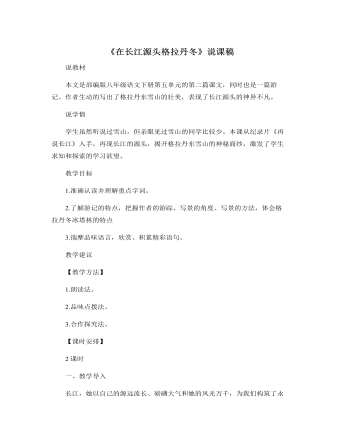
部编版语文八年级下册《在长江源头各拉丹冬》说课稿
说教材本文是部编版八年级语文下册第五单元的第二篇课文,同时也是一篇游记。作者生动的写出了格拉丹东雪山的壮美,表现了长江源头的神异不凡。说学情学生虽然听说过雪山,但亲眼见过雪山的同学比较少。本课从纪录片《再说长江》入手,再现长江的源头,揭开格拉丹东雪山的神秘面纱,激发了学生求知和探索的学习欲望。教学目标1.准确认读并理解重点字词。2.了解游记的特点,把握作者的游踪、写景的角度、写景的方法,体会格拉丹冬冰塔林的特点3.揣摩品味语言,欣赏、积累精彩语句。教学建议【教学方法】1.朗读法。2.品味点拨法。3.合作探究法。【课时安排】2课时一、教学导入长江,她以自己的源远流长、磅礴大气和她的风光万千,为我们构筑了永恒的大江之美,启发着一代又一代华夏儿女的激情与灵感,赢得了世人发自肺腑的赞美和感叹。今天我们来学习《在长江源头各拉丹冬》这篇文章,欣赏长江的源头各拉丹冬这片雪域高原的壮美景色。

人教版新目标初中英语九年级下册We’re trying to save the manatees教案2篇
本单元主要围绕着有关濒临灭绝的动物这一话题,学习了应该怎样保护我们的环境,以及就某一问题展开辩论。目标提示语言目标能够运用所学知识,就某一问题展开辩论。认知目标1、复习一些语法:现在进行时、一般现在时、用used to 表示一般过去时、现在完成时、一般过去时的被动语态。2、学会表达同意和不同意。3、学会以下基本句型:We’re trying to save the manatees.Manatees eat about 100 pounds of food a day.There used to be a lot of manatees.In 1972,it was discovered that they were endangered.Some of the swamps have become polluted.情感目标了解一些濒临灭绝的动物的生活习性和濒临灭绝的原因,教育学生应该如何保护环境。教学提示充分利用多媒体等教学设备,创设与本课话题相关的情境,如各种不同种类的动物、动物园以及有关环境的画画等等。围绕着本单元的教学目标,设计一些贴近学生实际的教学任务,如让学生谈论自己最喜欢的动物,如何拯救濒危动物,如何保护环境等等。让学生根据所学知识,就动物园是否对动物有利以及其他的话题进行辩论。

人教版新目标初中英语七年级下册How was your weekend教案2篇
Teaching Goal:1. General aims:Talk about recent past events2. Particular aims:A. Language Focus.Talk about recent past events and think of the past events.B. Language goalsHow was….?It was …What did …do over the weekend?C. Language structures:(1). How was your weekend? I was great. Pay attention to no form.(2). What did you do over the weekend? I played soccer. We went to the beach.D. Useful words and phrases:Words: was, did, went, beach, over, project, test, wasn’t, false, number, geography, spend, week, most, mixture, their, had, little, cook, read, saw, change, everyone, sit, sat, no, anythingPhrases: did one’s homework, played soccer, cleaned my room, went to the beach, played tennis, went to the movies, on Saturday morning, over the weekend, cook … for, what about, do some reading, have a party, talk show, go shoppingE. Grammar language:Present simple past tenseRegular and irregular verbsF. Learning strategies:Tour and holidaysG. Interdiscipinary:H. Emotion and manner:Teaching time: 5 periodsTeaching procedures:Period One教学步骤、时间 教师活动 学生活动 媒体应用Step 1Free talk 3’ Ask some questions like:Who’s on duty today?What’s the weather like? Answer and talk about something.让同学们回答下列问题1. Do you like weekend? (Let some students answer)It takes them three minutes to talk about the question.2. Why do you like weekend? (let the students answer) Most of the students like the weekend此时教师用汉语问:“在周末期间问你干了什么?这句话用英语这么回答?Let the students guess.At last the teacher give them right answer3. What did you do over the weekend?(板书、学习)

人教版新目标初中英语七年级下册Where is the post office教案2篇
Period 2 (3a----Section B 2c)Preview(Pre-task): Key points: What laAdd another information about their pen pals----their language on the cardnguage does she/he speak?She/He speaks....Does she/he have any brothers and sisters? Does she/he speak English?Preview(Pre-task): Add another information about their pen pals----their language on the cardKey points: What language does she/he speak?She/He speaks....Does she/he have any brothers and sisters? Does she/he speak English?Step 1 Revision1.Revisionand dictation of the new words 2.Revise the drills they learned yesterday.(by pairwork and grammar exercise)Step 2 Leading-inT has a conversation with one student. The conversation is following:---Do you have a pen pal?---Yes, I do.---What's your pen pal's name? ---His/Her name is....---Where is your pen pal from? ---He/She is from...---Where does he/she live? ---He/She lives in....---What language does he/she speak?He/She speaks...Write the new words on the Bb. They are following: EnglishChineseJapaneseFrenchStep 3 LearnLearn the new words with the whole class.Finish 3a with the students3b Pairwork T still does an example with one student Then the Ss practise in pairs. The example is following:--Curry Muray is my pen pal. He is from the United States.---What language does he speak?

人教版新目标初中英语七年级下册I want to be an actor教案2篇
三、教学建议第一课时:1. Lead in (Vocabulary)A) Before class, teacher should collect some pictures of working places. For example: Bank, TV Station, Restaurant, Police Station, Hospital ...B) In class, show students the pictures (PowerPoint, OHP). Ask students to tell the name of the working places and the name of the jobs.Shop assistant, doctor, actor, reporter, police office, waiter, bank clerk, studentC) Do exercise 1a and 3a.2. Bingo GameAsk groups of students to make up pairs of cards with a job on one and the related workplace on the other. For example, waiter / restaurant, teacher / school, doctor / hospital. Encourage students to use both the job / workplace combinations in the book and the ones that students came up during class discussions. Be sure they have twice as many sets of cards as there are students in the group. They can make two sets of cards for a single job / workplace, if necessary. Then have each group mix up its set of cards and hand their cards out in random order. Each time a student gets a pair of cards that match, he or she can lay these cards down. The goal is to have no cards in your hand at the end.3. Task OneA) Ask students to work in pairs and ask the partner what does he / she want to be in the future.e. g. :What do you / does he / does she want to be?I want to be a.Why?Because it's (adj).B) Vocabulary: Section B, 1a4. Homework 1.2.

人教版新目标初中英语八年级下册If you go to the party, you’ll have a great time教案2篇
区分宾语从句、定于从句和状语从句宾语从句和状语从句,都叫做主从复合句。宾语从句主要是中考必考的,是初中阶段必掌握的从句,宾语从句主要是掌握三要素,所谓宾语从句,就是宾语在主从复合句当中充当宾语的一个句子,叫做宾语从句。主句的谓语动词是及物动词,后面如果是词或者是短语的话,是简单句,如果是句子的话,肯定是宾语从句。I know that he good at English.就是宾语从句,三要素,一要素是要注意连词,连词一共学了三类连词,一类连词是that口语当中可以省略,就像刚才说的那一句,I hear he is good at English.还有疑问代词、疑问副词,how where when,疑问代词、疑问副词。还有一类连词weather是否的意思,不是状语从句当中的如果,这一定要和如果区分开,这是是否。I don't know if he interested at English。宾语从句要注意if是连词。第二要素是语序,要用陈述举语序。比如说你家有几口人,我们都说How many people are there in you family?但是这是简单句,一旦说成宾语从句,你可以告诉我你家有几口人吗?Could you tell me how many people there are in you family ?

人教版新目标初中英语八年级下册It’s a nice day, isn’t it教案2篇
"Hello! Welcome to English class! Introduce yourself. Meet your new classmates." That's what the teacher says. What do you say? "Oh no!" It can be difficult talking to new people. But it can be fun, and you can make friends. How do you do it? Make small talk. Small talk is polite conversation. "Wang Nan is a great pingpang player, isn't she?" "I'd love to meet her, wouldn't you?" "It's been raining a lot, hasn't it?" Tag questions are a form of polite speech. To make small talk successfully, you should know how to make them. You should also know what topics to talk about. Try to learn this unit carefully. The next time you're in English class, you'll find out. Making small talk's easy, isn't it? (“你好!欢迎你!请做一下自我介绍。认识一下你的新同学。”通常在课上老师会这样说。你会说什么呢?“噢,不!”与陌生人谈话太困难了。但是这也很有意思,并且你还能交到朋友。你该怎么做呢?闲聊。闲聊指得是礼貌的对话。“王楠是一个很棒的乒乓球运动员,不是吗?”“我希望自己能认识她,你呢?“今年的雨水很多,不是吗?”反意疑问句是一种礼貌用语。为了使得谈话成功,你应该知道怎样去进行闲聊。你还应该知道与不同的人该谈论什么样的话题。认真的学习这个单元吧,下次在英语课上,你会发现与大家展开谈话是一件很容易的事情,不信我们来试试。)

人教版新目标初中英语八年级下册He said I was hard-working教案2篇
This activity introduces some new vocabulary and provide oral practice using the target language.Task 1 . Ask four students to stand in front of the class, and the teacher asks them the following questions as a reporter.1.What are you going to do when you grow up?2.What are you going to do next week?3.What are going to do after school?The students will give different answers, then ask a good student to report what they said.I am going to e a doctor.What did she say?----------She said she was going to be a doctor.I am going to have a party on Friday night.What did he say?-------He said he was going to have a party on Friday night.I am going to do my homework.What did she say ?------ She said she was going to do her homework.I am going home after school.What did she say?-----She said she was going home after school.Say In this unit we are going to learn to use words like to report what someone said.Task 2. Read the instructions. Then ask a student to read the four questions. And write the words on the Bb. Explain what soap opera is.Task 3. Ask the students to Look at the pictures, point out the TV screens in the picture. Ask one girl to read what Marcia said.What did Marcia say? She said She said she was having a surprise party for Lana on Friday night. Repeat the other pictures in the same way.Activity3. Listen and number the pictures in activity 1a.

人教版新目标初中英语八年级下册How long have you been collecting shells教案2篇
Step Ⅱ Show the new words on the screen and teach the new words. Read the new words to students and ask them to repeat.Step Ⅲ 3aThis activity introduces new vocabulary and provides reading practice using the target language.In this activity first look at the four pictures.T: What can you see in the pictures?Ss: Four snow globes.T: Right. There are four snow globes in the pictures. And what are they?Ss: They are a monster, two polar bears, two penguins and a birthday cake.Write these words on the blackboard: snow globe; monster; polar bear; penguin and birthday cake. Read them to the class and ask students to repeat each one. Make sure students understand each word.Use a computer to show the E-mail message on the screen and read the message to students.Get students to read the e-mail on their own, and then draw lines connecting each snow globe and its description.Correct the answers.AnswersA line should connect each snow globe picture with the words that describe it in the letter.Step Ⅳ 3bThis activity provides writing practice using the target language.First review Activity 2a on Page 47.Then ask students to complete the message according to Activity 2a.Some partial sentences are given to students. Write about one person's collection.When students work, walk around the room checking the progress and offering help as needed.When they finish, ask some students to read their messages to the class.

人教版新目标初中英语八年级下册What were you doing when the UFO arrived教案2篇
(一).知识方面: 1.培养学生能运用过去进行时来描述、谈论过去某个时间正在发生的事情或动作的意识和能力,能就过去某个时间正在发生的动作做出正确的描述。 2.培养学生的想象力和角色扮演的合作能力。 3.培养学生讲述过去发生的事情经过的能力。能正确运用一般过去时来讲述故事。 (二).技能方面: 1.本单元的语言目标是Talk about past events and tell a story(谈论过去的时间和讲述一个故事),围绕这一目标,要涉及句型: What were you doing when the UFO arrived? ----I was sitting in the barber’s chair. The barber was cutting my hair. 因此必须学习standing、studying、cleaning、sleeping、cooking、making、eating、cutting、等表示地点的词,以便为上述句型提供语言材料。2.学习过去进行时的有关知识。Was/were+现在分词,是该时态的表达式。 3.在学习过程中,要区分The boy was walking down the street when the UFO landed.和While the boy was walking down the street, the UFO landed.这两种由when和while引导的状语从句的句型结构。注意它们的不同。

